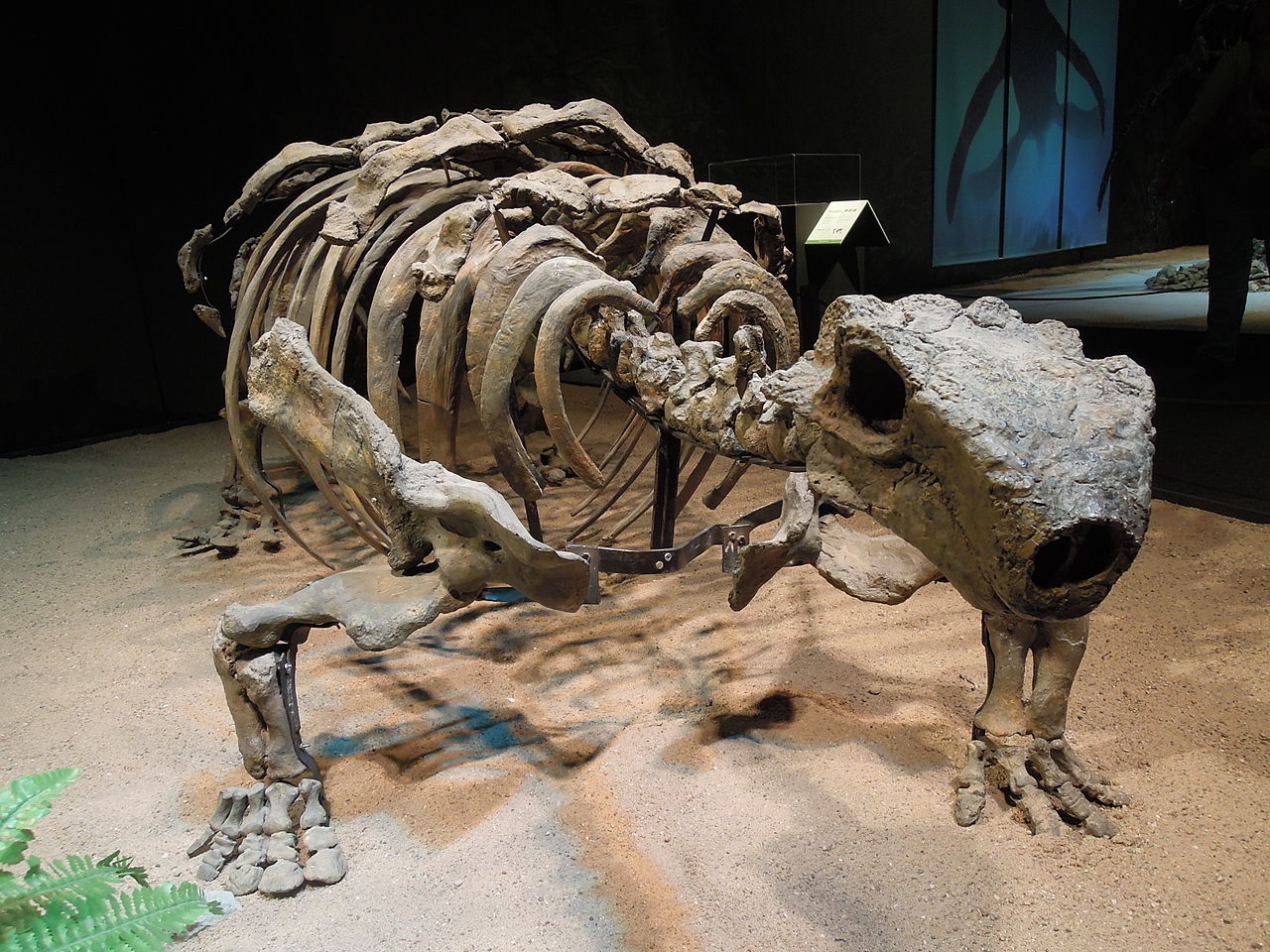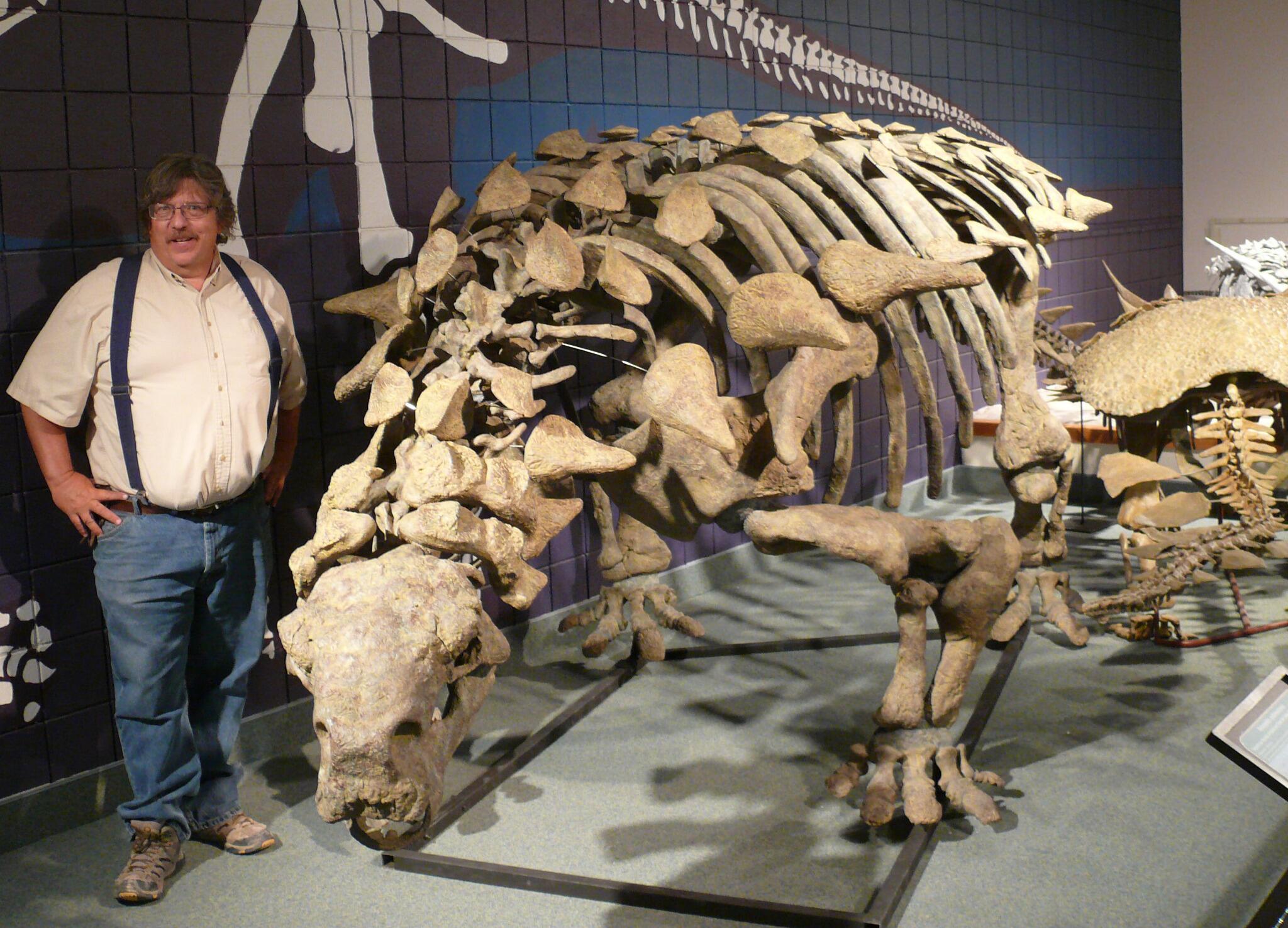 |
| Talarurus plicatospineus wiki. Radim Holis |
But before we get to the topic of ankylo paleoecology I want to address the myth of the slow, lumbering, passively defensive ankylosaur. Ankylosaurs are often compared to the extinct glyptodonts or the giant horned tortoise of Australia/Oceania Meiolania. Both types of animals were certainly not fleet of foot or agile in any sense of the word. They have columnar, short legs, plantigrade stance and lack the muscle attachments for strong leveraging muscles
of the leg. But ankylosaurs differ from tortoises and glyptodonts in several important musculo-skeletal details. They have strong deltopectoral crests on their front legs as well as robust back legs. Unlike stegosaurs, sauropods, humans, and elephants they were not plantigrade but digitigrade- suggesting some cursorial ability. And although ankylosaurs (indcluding nodosaurs- for our purposes here I am lumping them together) were not world champion sprinters by any means their whole musculo-skeletal anatomy is not too dissimilar to hippos as a whole. What I am trying to say is that the average reader of this blog would not be able to outpace a charging ankylosaur- just as hippos are surprisingly capable of a good show of speed, ankylos likely would have done the same.
Back to the lifestyle of ankylos however...
I should preface this post by mentioning that there was probably no "one type" of ankylosaur lifestyle. As I mentioned on one of my earliest posts which I did on Tarchia- where I argued it may have exploited social insects to some extent - small anatomical differences can account for huge behavioral difference between closely related species. Consider the family ursidae -the bears- all of which share a fundamentally conservative bauplan, but differ remarkably in diet from orchid eating spectacled bears to seal eating polar bears. From this I argue that there was enough diversity of design that some type of ankylosaurids were not typical herbivores - at least as we think of mega-herbivores today. Consider the strange and enigmatic Saichania chulsanensis pictured below.
 |
| Adult Saichania skull. James Kirkland (c) |
The primitive North American ankylosaur Peloroplites cedrimontanus gives us a good view of what a ankylosaur dedicated to herbivory looks like. It was a shock to see just how big this thing got but
 |
| Peloroplites cedrimontanus. James Kirkland (c) |
 |
| Talarurus plicatospineus. James Kirkland |
If all ankylosaurs were equally herbivorous we should see equally strong adaptations to mega-herbivory like we see in Peloroplites - but we don't. So how were these slack jawed members of the family making a living?
In my opinion they were exploiting ecological space that simply does not exist in modern mammalian ecosystems. More specifically many types were exploiting a microniche that we do not have a proper analogue for today - super archosaurian herbivore nesting colonies.
Consider these peculiarities of ankylosaur taphonomy:
1) Despite a solid armor frame and large size ankylosaurs are never particularly abundant as preserved fossils - with the possible exception of some sites in Early Cretaceous Utah Cloverly formation and perhaps some locales in Mongolia and China. During this time hadrosaurids/ceratopsids shared dominance in varying degrees.
2) Although never common, they were ubiquitous across Laurasia during most of the Cretaceous -suggesting they had a successful niche
3) Ankylosaurs are often associated with other known colony nesting dinosaurs. Examples include Pinacosaurus associated with Protoceratops/Oviraptors in the Djadochta of Mongolia. Up to three types of ankylosaurs in the Maisaura dominated Two Medicine formation. Basically wherever you see ceratopsids and hadrosaurids, both of which were likely communal nesters, you see at least one type of ankylosaur.
Herbivorous dinosaur nesting colonies must have been weird and unique places. Of course the comparison of a large sea-bird nesting colony is what immediately comes to mind. But there is the important difference that instead of feeding on fish/krill/squid- this colony depended on vegetation. In modern sea-bird colonies there are dedicated specialists that derive their livelihood from the colony. What comes to mind are gulls and skuas - stealing fish or even eggs/hatchlings. Maybe you know of the Striated Caracara. The weird Sheathbill makes a living in subantarctic islands off of faeces, eggs, carrion and seal afterbirth. In addition to the theropods, pterosaurs, and other carnivores attracted to a colony of nesting dinosaurs a panoply of other resources would have attracted any animal with the ability to exploit them.
Let's consider the opportunities for an ankylosaur in such an environment.
Dung. lots of dung. Its not just your dog that likes that stuff. If dinos were rear fermenters as seems likely there was probably loads of undigested stuff in their poo, in addition to bacterial synthesized B-vitamins. If the dung got to age a bit ankylosaurs could have enjoyed any insects attracted to it as well as any fungi growing on it. Both good protein.
Notice that the weak dentition and good sense of smell work well with a diet of coprophagy. Maybe some types of ankylos were full time coprophagists- ghosting herds of dinos as they travelled. Their copious guts would have extracted every bit of nutrition from the partially digested faeces.
Raiding the nest. Who is to say that ankylosaurs were not expert nest raiders? Their low slung build would have helped them get close and then once they were locked in with that sense of smell even a determined mamma dino would have been frustrated by their armor, pugnacious attitude, and tail club. Notice here how the body armor, generally invoked as anti predatory device, serves a dual function of protecting it from blows from enraged nesting parents. Once upon the nest the stout ankylo would have been about as difficult to move as Zack Randolf off the block.
Seen in this light the sense of smell, mobile muscular tongue and weak teeth of many ankylosaurs make perfect sense for gobbling up eggs. Their beak would have easily cracked the shell and those stout forelimbs would have dug up the eggs no problem. Maybe rotten eggs were especially relished.
If mother dinosaurs provisioned their young with regurgitated food or crop milk then even more opportunities for ankylosaurs are opened up. One can easily imagine a greedy fat Edmontonia shoving aside a group of baby Maisaura to get at whatever gruel mommy threw up for them.
 |
| Tarchia v Saurolophus. Sergey Krasovskiy (c) |
If some ankylosaurs acted as kleptoparasites of dinosaur nesting sites then they lived a decidedly feast/famine lifestyle. During the off season vegetation overall was still probably their mainstay, augmented perhaps by insects, carrion, dung, aquatic plants, dirt, bones, detritus, fruit and who knows what other weird stuff - maybe in the drier habitats they ate bio-crusts? I like to think of ankylosaurs as the mobile compost bins of the Mesozoic - making a living off the waste of others. Stinky, round, and pugnacious.
Cheers!!!
Carpenter, Kenneth. Ankylosaurs from Price River Quarries, Cedar Mountain Formation east-central Utah. Journal of Vert Paleo 2008
Support me on Patreon.
Like antediluvian salad on facebook.
Watch me on Deviantart @NashD1.Subscribe to my youtube channel Duane Nash.
My other blog southlandbeaver.blogspot.



2 comments:
At a guess, there are two bits of evidence that would bolster this case: bones and coprolites.
If Tarchia was raiding nesting-grounds, that is presumably a seasonal resource. Xeric environments are lush only during the wet season, so nest predators would presumably gorge during the wet season, and fast during the dry season. One would expect their bones to therefore show a strong seasonal signal, with banded growth patterns.
Additionally coprophagy has one danger that the dinosaur is picking up a lot of parasites from the dinosaur poop. It would have to have a cast-iron digestive system to deal with this, but still, I'd expect them to be more parasitized, on average, than were the dinosaurs they were scavenging. Some parasites leave osteological traces, so if it turns out that anklyosaur bones, on average, should more damage than did those of herbivores in the same fossil deposit, this would be indirect evidence that they were coprophages.
Finally, if anyone finds Tarchia dung (presumably preserved in situ), they need to do an analysis of what it contains. Hadrosaur dung does contain fungal spores, so coprolites can be counted on to contain a lot of information.
Good points.
I have thought about possible lines of evidence of nest raiding/coprophagy for ankylosaurs including the ones you mentioned. I can't find any references to lags (lines of arrested growth) in ankylosaurs. The issue with parasites is one I have considered- maybe the greatly expanded torso of ankylosaurs could deal with relatively toxic stuff like parasites, bacteria, fungi etc.
As you, or anyone else who reads this blog for that matter, probably notices- I do venture heavily into speculative conjecture- but maybe some type of line of evidence will come about some day that bolsters my ideas or disproves them.
For me the issues with ankylosaurs that suggest they were up to some weird stuff were the seemingly underdeveloped dentition, even in dry habitats, olfactory abilitieis, tongue musculature and the ubiquitous yet rare occurrence of these taxa. Horner 2011 found Ankylosaurus- the most famed type- to account for about 1% of the Hell Creek fauna. For these reasons I think that some of these beasts were up to some stuff not typical of mega-herbivores.
Its also interesting that various south american notosuchids/terrestrial crocs may have been filling some of the same ecological roles there-where ankylosaurs were absent or very sparsely distributed.
Post a Comment